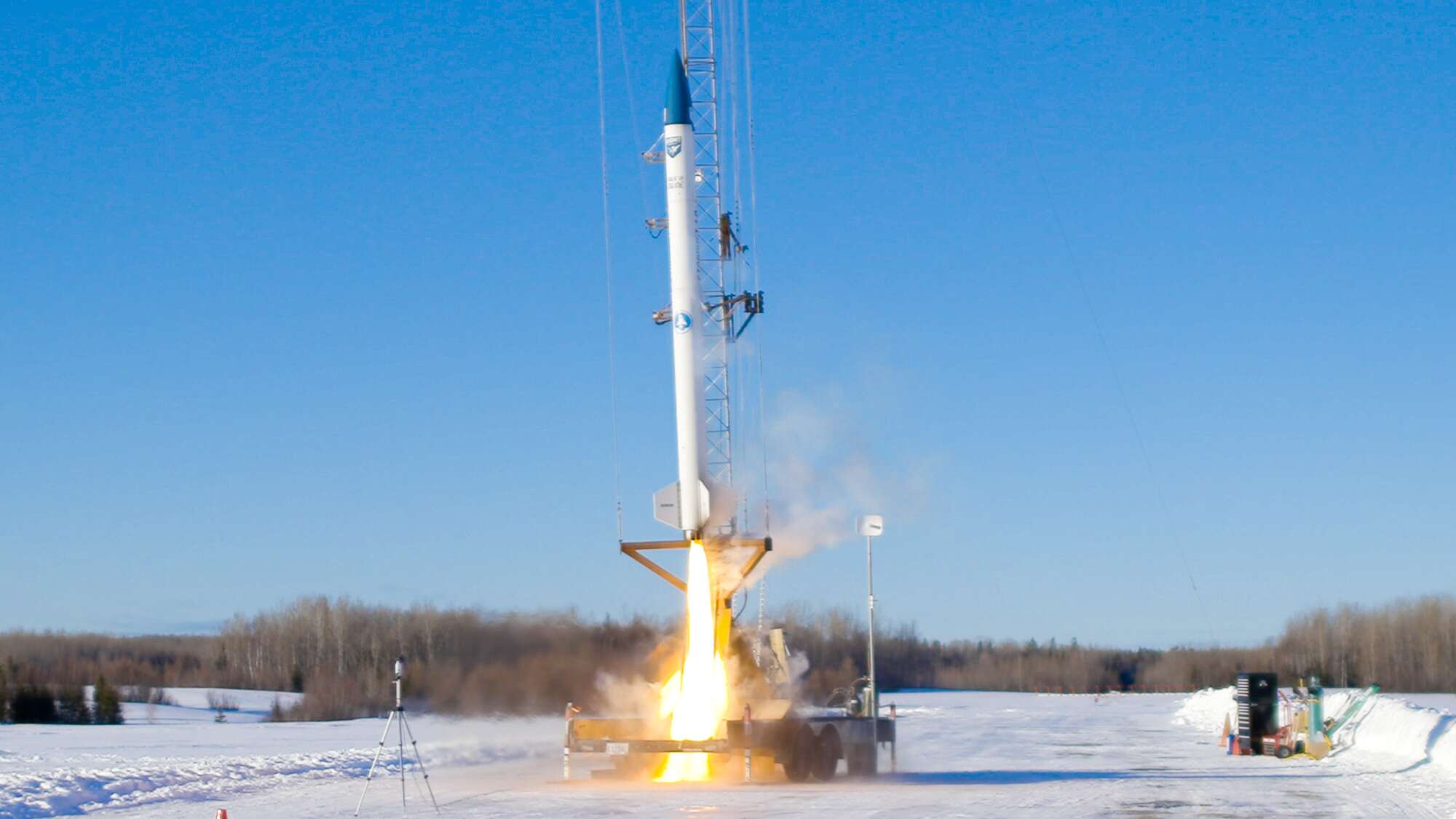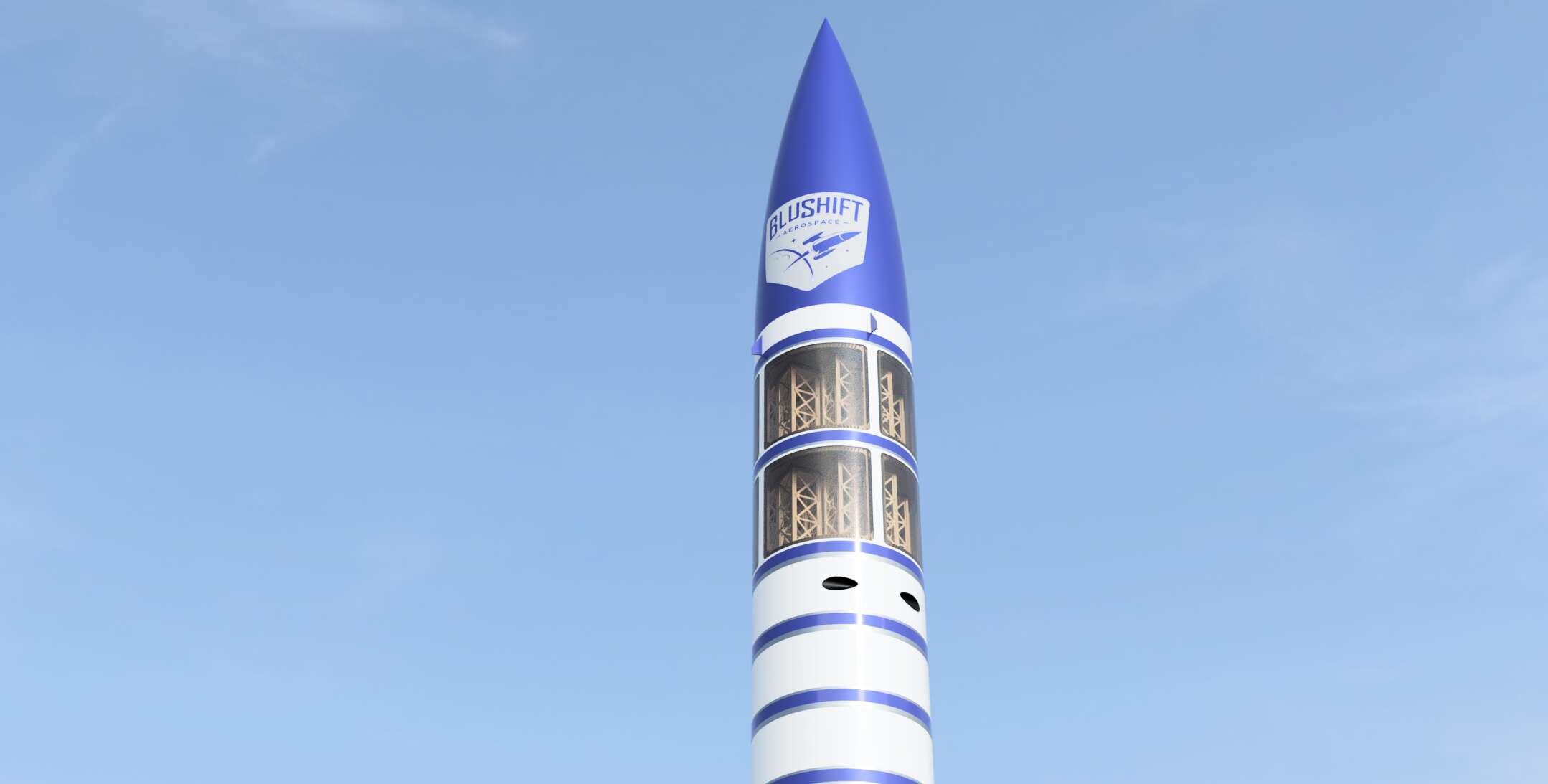
With fundraising underway, rocket-maker bluShift looks for coastal launch site
 Courtesy / BluShift Aerospace
BluShift Aerospace CEO and founder Sascha Deri, seen here in a virtual investor call Wednesday, said the company’s crowd equity funding campaign is nearing its first target. The fuselage of bluShift's prototype Stardust 1.0 is to the left.
Courtesy / BluShift Aerospace
BluShift Aerospace CEO and founder Sascha Deri, seen here in a virtual investor call Wednesday, said the company’s crowd equity funding campaign is nearing its first target. The fuselage of bluShift's prototype Stardust 1.0 is to the left.
As bluShift Aerospace approaches its first target for crowd equity funding, the Brunswick-based company said it’s also making headway in identifying a coastal site for its next rocket launch.
Fundraising
“We’re super-duper close,” Sascha Deri, bluShift’s CEO and founder, said — in typical sunny fashion — about reaching the company’s initial fundraising target of $500,000, which is half the total campaign.
On Jan. 31, bluShift launched its first prototype rocket, called the Stardust 1.0, which flew up less than a mile with several small customer payloads from Loring Commerce Centre in Limestone. It was Maine’s first commercial rocket and the world's first biofuel-powered commercial prototype rocket.
Before the launch, Deri said, conversation in the industry around renewable, “earth-friendly” fuel was “more like a joke and nobody considered it seriously.”
He continued, “I think we’ve changed the perspective.”

The launch positioned the team to build a full-size engine for successively larger rockets, with the goal of developing an “Uber to space” capable of carrying academic and commercial customer payloads into space.
Originally planning to go after conventional venture capital and angel investment for its next round of capital, bluShift instead turned to "crowd equity funding," which takes crowdfunding to the next level by allowing small investors to take a small equity stake in the company.
The company set up the campaign in late March on a platform called Wefunder. The funds will go toward further develop rockets using its proprietary bio-derived rocket fuel and modular hybrid engine.
The campaign is about $10,000 away from its first milestone of $500,000, Deri said during a virtual investor call Wednesday. The company must meet that target to get that first tranche of funds released, he said.
“It’s our bare minimum amount,” he said.
The funds will allow the company to build out and test its full-size engine, called the Modular Adaptable Rocket Engine for Vehicle Launch, or MAREVL for short.
Those tests will be conducted at Brunswick Landing, where the company has its headquarters.
The total goal for the campaign is $1.07 million.
Investments to date have allowed bluShift to double its engineering team and accelerate research and development.

Starless Rogue
The engine will go into the next rocket iteration — the 50-foot-tall Starless Rogue, which is expected to fly to suborbital space.
The goal for Starless Rogue, Deri said, is to perform a “beta” launch in the spring of 2022, with a subsequent launch to space that summer.
To get to that point, the company needs to raise total of $2 million, he said.
“We’re one-quarter of the way there,” he said.
Similar to Stardust 1.0, Starless Rogue will be equipped to parachute back down to earth, with the goal of landing in the ocean for retrieval and reuse. Starless Rogue will be equipped with two payload bays able to accommodate bulky payloads up to 2 feet in diameter and up to 30 kilograms or about 66 pounds.

“We want to allow people to put bulky payloads in there,” Deri said. “That’s a game-changer.”
Other funding sources
The company is seeking money from other sources as well. It’s a finalist in Greenlight Maine, an entrepreneurial competition for a $25,000 cash prize. A final Greenlight decision is expected in July. It has plans to compete in LaunchPad 2021, a similar competition sponsored by Gorham Savings Bank.
And last week, he said, bluShift received the first half of a loan of up to $300,000 from Maine Technology Institute. Award of the incremental loan is based on the company meeting its crowdfunding targets, he said. Payback, he said, begins in 2024, which is when the company expects to be generating revenue.
The company will likely apply for additional Small Business Innovation Research grants and NASA grants, and is looking at a Series A venture capital round at some point, he said.
Longer term, the goal is to raise $5 million and create 40 aerospace jobs in five years.
Launch site
Another challenge, Deri said, has been identifying a remote coastal site where bluShift can launch over the ocean.
“This has been a toughie,” he said.
However, word has gotten out that the company is looking for a site. Deri said he and Bob Bayer, a University of Maine professor emeritus and lobster expert who has deep connections with Maine’s coastal communities, have been traveling along the coast and peninsulas, from Bar Harbor to Cutler, looking for options.
“We have some exciting possibilities,” he said.
He added that he’s reached out to a number of landowners.
“I’m in strong dialogue with one set of families on one peninsula,” he said.
Another possibility is on an island that’s off Swan’s Island, which is 10 miles from the southern coast of Mount Desert Island. He plans to visit the island Friday.
After Starless Rogue, bluShift intends to build a 78-foot rocket dubbed Red Dwarf, designed as a polar low-earth orbit launch vehicle to meet the needs of the nanosatellite launch community.










0 Comments